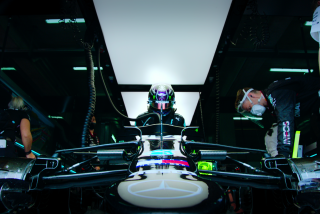America’s Cup Yachts Hoist Sales in Breeze
- Share via
SAN DIEGO — “The America’s Cup isn’t about making money,” said New Zealand yacht designer Bruce Farr not too many years ago. “It’s about spending money.”
That may have been true once upon a time in a faraway place. But this is Southern California 1992, recessionary land of empty hotel rooms and half-finished high-rises, and the Cup today is clearly about making money -- or at least trying to.
The new commercialism of yachting’s premier event is hard to miss. Iain Murray’s garish, yellow-and-green Cup racer, Spirit of Australia, comes as close to a stock car as a yacht is likely to get, with the logos of Qantas Airlines, Holden cars and other sponsors slathered down the sides and billowing spinnakers flying the colors of Bundaberg Rum and IBM.
With advertising permitted on the boats for the first time in a full-fledged Cup regatta, Dennis Conner’s spinnakers and gunwales bear the familiar names of Cadillac, Pepsi, American Airlines and Bank of America. So what does a mass-market product expect to gain by associating with an elitist sport such as sailing?
“Shelf space,” said Pepsi spokesman Andrew Giangola, mincing no words. “That’s the core of our business, and the key to getting it is good relations with retailers -- supermarkets, convenience stores and mass marketers.”
And how does that manage to dovetail with Pepsi’s estimated $3 million sponsorship of Team Dennis Conner?
“Dennis gives us a unique opportunity to leverage our relationships with the trade,” said Giangola. Translated, that means trips to Cup races and face-to-face meetings with the great man himself, maybe even a ride on Stars & Stripes, as choice perks for retailing executives.
“The idea at Pepsi is: Expect the unexpected,” said Giangola of the curious association. “Capture the moment, as we did with Jimmy Connors, Magic Johnson, Bo Jackson, Joe Montana. We’re not trying to capitalize opportunistically. We’re just trying to be fresh and new.”
Uh-huh. ...
So that’s what it’s come to here on the placid Pacific -- pushing product, which is a long way philosophically from the Cup’s roots in the stodgy, corinthian yachting heart of the East, Newport, R.I. -- or is it?
Officials of the New York Yacht Club, the bastion of conservatism that held the Cup for a record 132 years before losing it in 1983, blame themselves in part for the changing nature of the event. “We’re the ones who first commercialized the Cup,” said ex-commodore Frank Snyder.
That was back in 1980, when the club began to wince over escalating costs of running its simon-pure, world-class regatta every three years. To offset the losses, they asked a club member to seek a few sponsors willing to kick in organizational money in return for use of the copyrighted Cup logo.
“That first year, I think they got three sponsors and raised about $30,000,” said Tom Ehman, longtime Cup insider and now executive director of the America’s Cup Organizing Committee. Sperry Topsider shoes, a little Rhode Island winemaker called Sakonnet and a life-jacket company were first on board, he said.
From those humble origins, a multimillion-dollar industry evolved. The 10 teams assembled here will have spent close to $300 million in their quest for the silver ewer by the time the final match arrives in May, the bulk of it from corporate sponsors. Television outlets in Europe, Australia, New Zealand and the United States will have shelled out $8 million for broadcast rights.
Louis Vuitton, the elegant French luggage maker, will spend $9 million sponsoring challenger trials; Citizen Watch Co. of America will lay out $7.5 million in its role as official timer, as a sponsor of Team Dennis Conner and on ad campaigns keyed to the Cup.
That alone is many times what it used to cost millionaires such as Baron Marcel Bich, Ted Turner and England’s Peter de Savary to run entire campaigns in the days when the Cup was just a sporting idyll for the rich to indulge themselves in for a summer.
Some say the change is for the better, some say it’s for the worse. J.J. Isler, an Olympic aspirant in the women’s 470 dinghy class and wife of ESPN Cup commentator Peter Isler, says the new emphasis on professionalism and secrecy in Cup camps is robbing the event of all its sportsmanship.
Olympic silver medalist John Kostecki, who worked briefly as a helmsman in Bill Koch’s $50 million America camp, says the high cost of competing is driving out potential participants. Kostecki thinks the Cup will wither away for lack of players if costs don’t come down.
Yet interest in the event has never been so high so early in the game, and sponsors remain optimistic the event will recapture the world attention it held in 1983, when Conner lost it in Newport, and in 1987 when he won it back in Australia.
ESPN will start its live telecasts on March 28, and will have run more than 100 hours of Cup coverage by the time the series finishes in May.
Coors Lite, a major donor to the four-boat America defense campaign, picked the affiliation as an image-maker too. “We’re looking for a real healthy, young image,” said spokeswoman Gina Frieze, “and the picture of a sailor is what we feel the Coors Lite drinker is.” Coors plans a major ad campaign later in the regatta, with billboard and TV ads picturing America flying the Coors colors.
But unlike Citizen and the other Conner sponsors, Coors won’t get the benefit of signage on America’s boats and sails during racing. Syndicate chief Bill Koch is bankrolling two-thirds of the cost of the campaign himself, and selling advertising space on the boats during competition would imperil the tax-exempt status of his own America contributions.
But even without the chance to put their names on the boat during racing, sponsors aplenty have come forth for America-Digital Equipment Corp., which is sinking a half-million dollars into high-tech hull-design work; AT&T; Hercules Aerospace, which built one of the four America hulls; Newsweek magazine; Mt. Gay Rum; Corvette cars.
The new Cup professionalism extends also to the sailors, some of whom are being paid handsomely even by American sports standards. Chris Dickson, who left his native New Zealand to take up residency in Japan and sail for the Nippon Challenge, reportedly is being paid in the $1 million range for his three-year stint; Paul Cayard, who left San Francisco to become a resident of Italy, is said to have commanded a similarly attractive package for running the Il Moro de Venezia campaign for its well-heeled sponsor, Montedison Corp.
Crewmen in most Cup camps are now on salary as well, and wear crew-issue uniforms touting the wares of corporate sponsors.
All of which puts the Cup a long way from its elegant origins, in the days when Sir Thomas Lipton and Harold Vanderbilt battled away in huge yachts unblemished by business affiliations.
Or did they?
“Whether by design or not,” said one veteran Cup observer, “Lipton tea cornered the U.S. market when Sir Thomas was sailing for the Cup.”
And Baron Bich’s Cup challenges in the 1970s coincided with the rise in popularity of his disposable Bic pens and cigarette lighters here. Ted Turner went straight from skippering Courageous to pioneering CNN, the eminently successful worldwide TV news network, and Alan Bond rose from a small-time west Australian businessman to a world financial figure during his ultimately successful quest for the Cup.
New Zealand’s Michael Fay followed suit, and along the way won a knighthood.
So maybe commercialism isn’t new, after all. Maybe it’s just the same old dog, wearing a different collar.
More to Read
Sign up for The Wild
We’ll help you find the best places to hike, bike and run, as well as the perfect silent spots for meditation and yoga.
You may occasionally receive promotional content from the Los Angeles Times.






